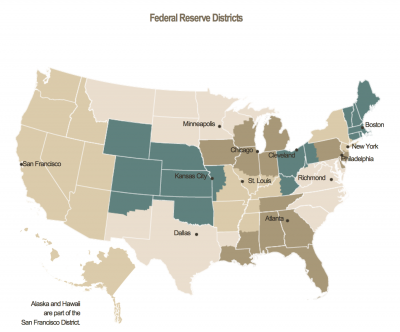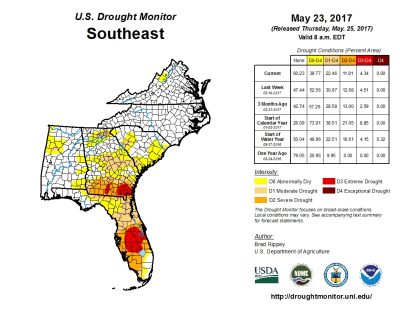Bloomberg's Leah Nylen reported Thursday that "a Colorado judge issued an order temporarily blocking the proposed $25 billion merger of Kroger Co. and Albertsons Cos., which has been challenged by…
Federal Reserve: Observations on the Ag Economy- May ’17
On Wednesday, the Federal Reserve Board released its May 2017 Beige Book update, a summary of commentary on current economic conditions by Federal Reserve District. The report included several observations pertaining to the U.S. agricultural economy.

* Fifth District- Richmond– “Agriculture conditions also improved slightly, particularly for beef and dairy farmers. In South Carolina, cotton and peanut planting was slightly behind schedule due to rain.”

* Sixth District- Atlanta– “Agriculture conditions across the District were mixed. By early-May, overall drought conditions had improved in Louisiana, Mississippi, and Tennessee while Alabama, Georgia, and Florida reported sizeable areas of drought conditions ranging from abnormally dry to extreme. The May forecast for Florida oranges was up slightly from April but remained considerably lower than last season’s production. District cotton, soybean, rice, and peanut plantings in early May were ahead of the five-year average, with the exception of Tennessee’s cotton and soybean crops and Florida’s peanut crop, which were modestly below their five-year averages. On a year-over-year basis, prices paid to farmers in March were up for cotton, soybeans, and broilers but remained down for corn, rice, beef, and eggs.”
Frt pg today's @ajc - Georgia peaches: 80 percent of state’s crop lost -https://t.co/dRD4ynPF0J pic.twitter.com/X3z3A6khbj
— Farm Policy (@FarmPolicy) May 31, 2017
* Seventh District- Chicago– “The outlook for crop income was unchanged through April and early May despite wet weather slowing planting in much of the District. Corn and soybean planting was behind the pace of a typical year, and in some areas wet and cold spells killed crops that had already been planted. Corn and soybean prices were up slightly. Incomes for dairy farmers deteriorated a bit on balance. Some dairy operations in the District scrambled to find alternative buyers after new restrictions on imports of ultrafiltered milk into Canada cut demand for U.S. milk. Incomes for hog and cattle operations improved as prices increased in spite of ample supply. Michigan fruit growers faced increased uncertainty after a major freeze potentially damaged their plants.”
FrtPg business section today's @journalsentinel, "Soggy, cool spring delays planting for Wisconsin farmers," https://t.co/fJFYaHcq4j pic.twitter.com/W6OdAfLL7M
— Farm Policy (@FarmPolicy) May 26, 2017
* Eighth District- St. Louis– “Agriculture conditions deteriorated significantly due to flooding across the District. Mid-May percentages of corn and rice crops rated fair or better were down or unchanged from a year ago in every state for which data were reported. Flooding and rain also slowed planting, with planned acreage planted for corn, cotton, rice, and soybeans each below the percentages of the previous year. Cotton was the farthest off last year’s planting pace.”
Amazing photo on the front page of today's @stltoday - Interstate 55 pic.twitter.com/4PqlAXOiZi
— Farm Policy (@FarmPolicy) May 3, 2017
* Ninth District- Minneapolis– “District agricultural conditions remained weak since the previous report because of continued low commodity prices. However, growing conditions have improved. After heavy rains slowed early planting, progress as of mid-May was roughly on par with five-year averages in most District states.”
Ag Prices: The corn price, at $3.43 per bushel, is down 6 cents from last month and is down 13 cents from April 2016, @usda_nass pic.twitter.com/60xkY2yYfc
— Farm Policy (@FarmPolicy) May 31, 2017
* Tenth District- Kansas City– “Persistently weak farm income continued to weigh on the District’s farm economy and agricultural credit conditions.
District contacts reported that wheat and corn prices remained below profitable levels.
“Soybean prices were also lower than in the previous year, but remained mostly profitable. Cattle prices increased since the previous reporting period and feedlots reported a modest increase in profits. However, adverse weather and wildfires in the western portion of the District reduced production expectations for cattle and wheat in the region. More generally, bankers in the western portion of the District reported a sharper decline in farm income and credit conditions than bankers in the eastern portion. Overall, District bankers continued to report weaker repayment rates on agricultural loans and an increase in borrowers with carry-over debt.”
Snapshot Of Farm Lending In Present Economy-- Nathan Kauffman of @KansasCityFed, via @USDA radio-- https://t.co/HzAtHuj1eT (MP3 1min).
— Farm Policy (@FarmPolicy) May 31, 2017
* Eleventh District- Dallas– “Moisture levels remained favorable across the district. The wheat crop was in good shape and harvest was getting underway, although acreage was down from last year because prices were below the cost of production. Production prospects for corn and sorghum were strong.
This year is expected to be a good one for Texas cotton, with a sharp rise in acres planted prompted by relatively high prices, and strong yields expected due to good subsoil moisture. Demand for cotton continued to be strong, particularly for exports.
* Twelfth District- San Francisco– “Conditions in the agriculture sector were mixed. A wet winter in much of the West boosted water supplies and improved crop yields. However, cool wet weather delayed some plantings in Idaho. One contact in the Mountain West noted that credit demand from the agriculture sector softened as overall growing conditions remained challenging and yields were down somewhat. Demand from canneries for tomatoes softened, and the number of new tomato plantings is expected to decline. While contacts in the agricultural export sector reported optimism that rising global demand would boost overall sales, they continued to express concerns over competition from foreign producers and the still elevated dollar.”





